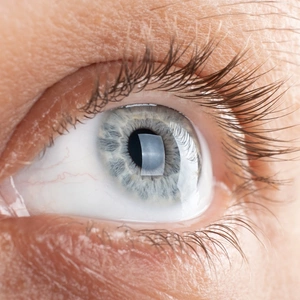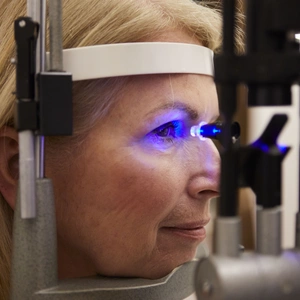Dry eye syndrome
If your eyes aren’t making enough tears, or the tears you produce are drying up too quickly, you may have dry eye syndrome, also known as keratoconjunctivitis sicca. This can cause discomfort, result in the eye becoming inflamed, and in some cases, it can cause vision problems.
Dry eye syndrome is very common and can occur at any age. However, it mainly tends to affect people over 50, with women more susceptible than men.
Dry eye syndrome symptoms
Some common symptoms of dry eye syndrome include:
- a sandy, gritty or scratchy feeling, as though there is something in your eye
- itching, burning or stinging eyes
- red eyes
- painful eyes
- eyelids stuck together and crusty eyelashes first thing in the morning
- tired eyes
- inability to cry
- blurry vision
- vision fluctuation and difficulties reading
- heavy eyelids or difficulty opening your eyes
- excessive blinking or eyelid twitching
Additionally, although not normally serious, severe dry eye syndrome that is left untreated can cause symptoms such as extreme sensitivity to light, red eyes, very painful eyes and blurred vision.
When to see a consultant?
Generally, the symptoms of dry eye will not go away on their own, and it’s best to treat them early. As a result, if you think you have dry eye syndrome, it’s important to speak to an ophthalmologist or optometrist right away.
If it goes untreated for a long time, dry eye syndrome has the potential to cause complications such as loss of vision, corneal scarring and conjunctivitis.
You can request an appointment with one of the eye specialists from The London Clinic Eye Centre here.
* We offer fast appointments Monday - Friday only.
Other dry eye syndrome causes
Blepharitis is the most common cause of dry eye. Blepharitis is a condition in which the glands along the edge of the eyelid, called Meibomian glands, become inflamed, blocked or impaired. This is called meibomian gland dysfunction (MGD).
In this condition, the glands don't produce a good lipid layer, resulting in increased tear evaporation and instability. Treating any blepharitis (MGD) is usually a core aspect of dry eye treatment.
Dry eye syndrome can be caused by certain medications, such as antihistamines, antidepressants, beta-blockers, diuretics, pain medications, nasal decongestants, oral contraceptives, chemotherapy drugs and some blood pressure medications.
Eye drops which contain preservatives may also contribute to dry eye, particularly if used in the long term – for example, for treatment of glaucoma. Some drops directly exacerbate dry eye by reducing tear production (such as topical beta blockers).
Some types of contact lenses can irritate the eyes and cause dry eye syndrome. However, the length of time you wear your contact lenses can also play a contributing role.
To avoid this, make sure you follow the advice for wearing contact lenses issued by your optometrist.
There are several health conditions, particularly inflammatory conditions, that are associated with dry eye. These include conjunctivitis, contact eczema, diabetes, polycystic ovary syndrome, thyroid disease, rheumatoid arthritis and immune system disorders like Sjögren's syndrome and lupus.
Sjogren’s syndrome is a specific disorder of the immune system and often accompanies other diseases such as rheumatoid arthritis and Lupus. In Sjogren’s syndrome, antibodies attack the moisture-secreting glands in the mouth (salivary glands), eyes (lacrimal glands), and other mucosal surfaces. This causes dry eyes and dry mouth.
Stevens-Johnson syndrome can also cause severe dry eye, alongside other serious eye problems. In this rare condition, a mild infection, or a medicine triggers an overreaction of the immune system which results in severe blistering of the mouth, eyes, and throat.
Having surgery on your eye – for example, cataract surgery or laser eye surgery – can increase your risk of dry eye.
Post-surgical dry eye symptoms usually improve once the eye has healed, but this can take time.
Environmental factors that may cause or make your dry eye symptoms worse include exposure to the sun, wind, warm air conditioning, dry climate and high altitude. This is because all these conditions can have a drying effect on your eyes, causing tears to evaporate.
Occupational activities that need a high level of sustained visual concentration, such as reading, writing, sewing, watching TV or computer work, tend to reduce blinking and can cause tears to evaporate, contributing to dry eyes.
Some hormones help to stimulate tear production. As a result, changes in hormone levels may contribute to dry eye symptoms.
In particular, people going through menopause and those who are pregnant or undergoing hormone replacement therapy (HRT) are more prone to developing dry eye syndrome.
As we age, our eyelids become less adept at spreading tears each time we blink. The various glands in our eyes that produce tears may also become less effective with age and the quality of the tears declines. This means that tear production reduces as we get older. As a result, dry eyes are often linked to ageing.
Dry eye syndrome treatments
Overall, there’s no cure for dry eye. However, there are treatments that your doctor may recommend to help manage the symptoms. Treatments include:
If your dry eye is caused by your contact lenses, air conditioning or too much screen time, it makes sense to make changes where possible.
Eye drops used to treat dry eye syndrome are referred to as artificial tears. They replace your natural tears to keep the surface of the eyes lubricated and are safe to use very frequently during the day.
Many brands of artificial tears are available, and they contain molecules and compounds designed to replace the layers of the natural tear film. Artificial tears provide symptomatic relief and are the mainstay of dry eye treatment.
We now believe that an important cause of dry eye is chronic inflammation of the eye surface. In some cases, a short course of steroid eye drops can be used under the supervision of an ophthalmologist or optometrist.
Long-term steroid eye drops are best avoided, but instead, long-term topical anti-inflammatory drops such as cyclosporine can be used.
Acetylcysteine drops are occasionally used for some types of dry eye. These drops break down the mucous in the tear film and reduce stickiness.
Oral courses of tetracycline tablets can also be used, as they have anti-inflammatory properties. These drugs are usually used when the dry eye is associated with blepharitis.
If other methods to treat your dry eye syndrome are not working, your doctor may recommend surgery. There are a few different surgical procedures that can be used, including:
- punctal plugs – a punctal plug provides a barrier in the tear duct to partially or fully block your tears from draining and help keep your eyes moisturised. Usually, a dissolvable punctal plug is used to temporarily block the tear duct. If this is beneficial, non dissolvable punctal plugs can be used to permanently block the tear ducts. Although classed as permanent, these plugs can be removed by your ophthalmologist if needed.
- intense pulsed light (IPL) therapy – IPL therapy uses pulses of light which are applied to the eyelids and eyelid margin. This selectively destroys vascular structures in the eyelid. This can help to reduce inflammation along the eyelid margin and improve how your meibomian glands function. This leads to improved tear quality.
- minor gland salivary auto transplant – this procedure involves implanting a salivary gland in place of your tear duct to help keep your eyes moisturised. It is rarely used, but may be beneficial for severe dry eye cases.

























